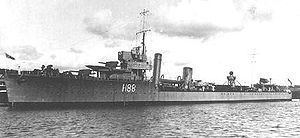Name HMS Wakeful Laid down 17 January 1917 Launched 6 October 1917 | Ordered 9 December 1916 Commissioned 16 December 1917 Construction started 17 January 1917 Length 91 m | |
 | ||
Motto Si dormiam capiar“If I sleep I may be caught” Builders William Beard and Company, John Brown & Company | ||
HMS Wakeful was a W-class destroyer of the Royal Navy. She was built under the 1916-17 Programme in the 10th Destroyer order. Wakeful was assigned to the Grand Fleet after completion, and served into the early years of the Second World War. Wakeful was torpedoed and sunk during Operation Dynamo by a German E-Boat on 29 May 1940.
Contents
First World War
Wakeful joined the Grand Fleet and was present at the surrender of the German High Seas Fleet in 1918. She then went into reserve.
Second World War
Just prior to the start of the war in August 1939 Wakeful was reactivated and recommissioned to attend the Royal Review of the Reserve Fleet in Weymouth Bay. At the outbreak of war Wakeful was assigned to convoy escort duty with the 17th Destroyer Flotilla, which was part of the Western Approaches Command.
Operation Dynamo
Wakeful was selected to support Operation Dynamo, the evacuation of allied troops from Dunkirk, on 26 May 1940. On 27 May 1940 Wakeful embarked 631 Allied troops. While returning them to Dover Wakeful came under air attack and received minor damage below the waterline. Despite the near miss Wakeful returned to Dunkirk to continue the evacuation, embarking 640 Allied troops on 28 May 1940. While carrying this out Wakeful was torpedoed by the German E-Boat S-30. The destroyer was struck by two torpedoes, one hitting the forward boiler room. Casualties were heavy, only one of the 640 allied troops and 25 of Wakeful's crew surviving. A number of ships stopped to pick up the survivors, but one of these, the destroyer Grafton, was then in turn sunk by a German U-Boat.
